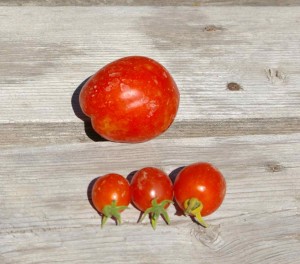Principe Borghese (also purchased from Territorial Seed Company) is the third variety of tomato that I grew this year. I liked the description and knew I had grown it about 15 years ago, but didn’t clearly remember the results. I didn’t include it in my review of Heinz and Stupice tomatoes because it wasn’t producing enough to compare. Now, with southwest Idaho’s first fall frost possible any time in September, the 5 plants are still only giving me a few handfuls of tomatoes per week. Here are what I see as the pros and cons of growing Principe Borghese tomatoes in my garden:
Pros:
- large, vigorous plants
- no problem with disease
- ripe tomatoes easy to prepare for canning (basically no core; just barely cut off stem end and toss whole or halved tomatoes in the blender to chop)
- tomatoes are a good salad size
- juicy tomatoes
Size comparison in two photos below of Principe Borghese tomatoes (which range from grape tomato size to cherry tomato size) and Heinz tomatoes (which are a standard plum or roma tomato size)


Cons:
- late to ripen for the southwest Idaho season
- plants so large and thick with branches that just cage support is inadequate (might work better with Dad’s trellis system)
- difficult to pick with the tangle of branches
- tedious to pick quickly, especially when not very many are ripe, because the fruit is so small
- not as sweet as cherry tomatoes we have grown
I grew all three tomato varieties within a few feet of each other, so nothing about watering, soil, or sunlight should have been significantly different for them. In the first photo below, you can see all 3 raised beds, each with a different kind of tomato plant. The Stupice tomatoes are in the fore front, the Heinz to the back right, and the Principe Borghese to the back left.

This next photo is a close up of the Principe Borghese plant, loaded with green tomatoes on top. I really have to dig under the plant right now to find any ripe ones, and it’s dark under there!

If I grow Principe Borghese tomatoes again, it will probably be just a single plant for fresh eating, not as a main crop for soups, sauces, and canning. But, next year, I will likely grow a cherry tomato plant instead.
